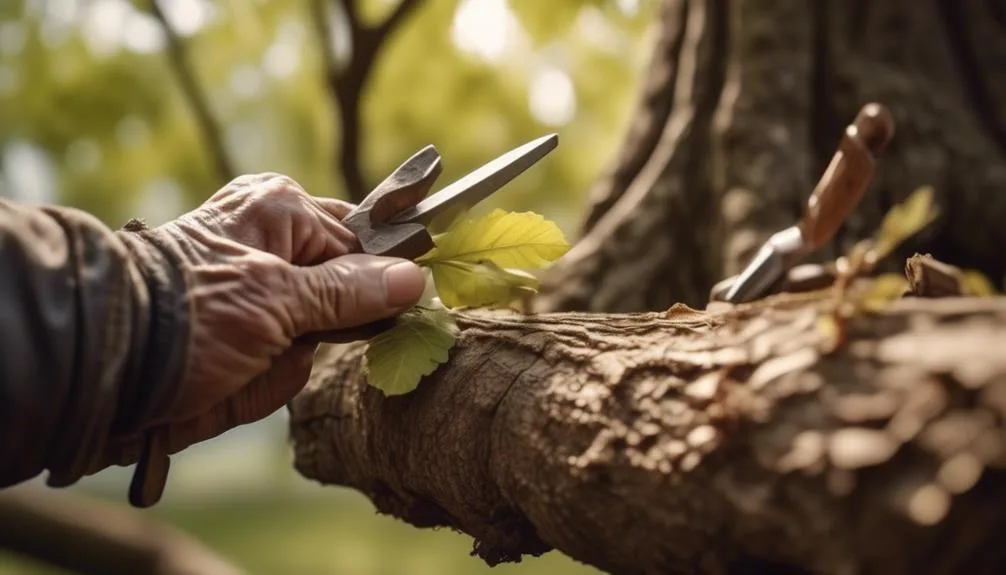Curious about grafting walnut trees to create a super tree? Grafting walnut trees allows you to combine the best traits of different varieties into one tree.
Before you start, it's important to consider the types of walnut trees suitable for grafting, as well as the best techniques and timing.
Grafting opens up a world of possibilities in horticulture, so let's explore the ins and outs of this fascinating practice.
Key Takeaways
- Selecting the right type of walnut tree for grafting involves considering desired traits and climate and soil conditions.
- Mastering grafting techniques such as bud grafting and T budding can lead to successful growth.
- Grafting walnut trees should be done during the dormant season with healthy, disease-free scion wood and rootstock.
- Factors affecting the success of walnut tree grafting include environmental conditions, rootstock compatibility, skill and precision in the grafting process, and optimal weather conditions.
Types of Walnut Trees for Grafting
When selecting types of walnut trees for grafting, it's important to consider the specific characteristics and qualities you want to achieve in the grafted tree.
First, consider the desired traits such as disease resistance, nut size, and overall tree vigor. For instance, if you want a tree that produces large, high-quality nuts, you might select a variety known for its excellent nut production.
Additionally, consider the climate and soil conditions of your location to ensure the selected tree is well-suited for the environment.
Once you have identified the desired traits, you can then choose the appropriate grafting tools such as a sharp grafting knife, grafting tape, and rootstock.
Suitable Grafting Techniques for Walnut Trees
Selecting suitable grafting techniques for walnut trees involves mastering the art of grafting and choosing the right approach to ensure the successful fusion of desired traits onto the selected rootstock. When considering suitable grafting techniques for walnut trees, it's important to keep the following in mind:
- Bud Grafting: Mastering the delicate process of bud grafting can allow you to join a single bud from the desired scion onto the rootstock, promoting successful growth.
- T Budding Techniques: T budding offers a reliable method for grafting walnut trees, allowing for the transfer of desired characteristics from the scion to the rootstock.
- Rootstock Compatibility and Scion Selection: Carefully consider the compatibility between the rootstock and scion to ensure successful grafting and the expression of desired traits.
Best Time to Graft Walnut Trees
The best time to graft walnut trees is during the dormant season, typically in late winter or early spring. This is when the trees are less active, making it easier for the graft to take hold.
Optimal conditions for grafting include selecting healthy, disease-free scion wood and rootstock. It's crucial to ensure that the scion and rootstock are compatible, as this greatly influences the success of the graft.
Prior to grafting season, it's advisable to conduct compatibility testing to determine the best pairing for successful grafting. By carefully selecting the rootstock and conducting compatibility testing, you can increase the chances of a successful graft.
Paying attention to the grafting season and following best practices for rootstock selection and compatibility testing are essential for successful walnut tree grafting.
Factors Affecting Success of Walnut Tree Grafting
To ensure the success of walnut tree grafting, understanding the factors that influence the graft's acceptance and growth is crucial.
Several key factors affect the success of walnut tree grafting:
- Environmental Conditions: The temperature, humidity, and overall climate can significantly impact the success of grafting. Ensure the grafting process takes place during optimal weather conditions to maximize the chances of success.
- Rootstock Compatibility: Selecting the right rootstock that's compatible with the scion is essential. Compatibility ensures that the graft union forms successfully and the tree thrives.
- Grafting Technique: The skill and precision with which the grafting process is carried out can greatly influence the success of the graft. Attention to detail and proper grafting techniques are essential for optimal results.
Common Challenges in Grafting Walnut Trees
Facing various hurdles during walnut tree grafting can be a daunting yet inevitable aspect of the process. Two common challenges in grafting walnut trees are grafting compatibility and disease resistance. Grafting compatibility refers to the ability of the scion and rootstock to successfully unite and grow together. It is crucial to select compatible varieties to ensure successful grafting. Disease resistance is another significant challenge, as certain diseases can hinder the success of the grafting process. Choosing disease-resistant rootstocks and scions can help mitigate this challenge. Below is a table summarizing these common challenges:
| Common Challenges in Grafting Walnut Trees |
|---|
| Grafting Compatibility |
| Disease Resistance |
Conclusion
In mastering the art of grafting walnut trees, you can unlock a world of possibilities for creating new varieties and improving tree health. With the right techniques and understanding of common challenges, you can achieve success in this rewarding endeavor.
So, with patience and practice, the potential of walnut tree grafting can be realized, allowing you to reap the benefits of your efforts.

